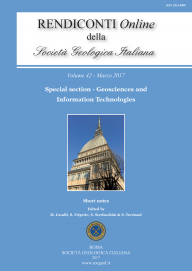
Monitoring soil organic carbon content using Vis-NIR spectroscopy: A case study in southern Italy
Massimo Conforti, Giorgio Matteucci & Gabriele Buttafuoco
National Research Council of Italy, Institute for Agricultural and Forest Systems in the Mediterranean (CNR ISAFOM), Rende, Italy.
Corresponding author e-mail: massimo.conforti@isafom.cnr.it.
Volume: 42/2017
Pages: 38-41
Abstract
Assessment and monitoring of soil organic carbon (SOC) quality are important for understanding SOC dynamics and developing management practices of soils. This study investigated the feasibility of visible and near infrared (Vis-NIR) spectroscopy as a fast method to determining and monitoring the SOC content in a mountains area of the Calabria region (southern Italy). In this study, a multitemporal data set including 299 topsoil samples was used: 208 soil samples were collected in 2012 whereas 91 in 2015. The soil samples were collected using a metallic core cylinder with a diameter of 7.5 cm and a height of 20 cm. The Vis-NIR reflectance of soil samples was measured in laboratory, under artificial light, using an ASD FieldSpec IV 350-2500 nm spectroradiometer (Analytical Spectral Devices Inc., Boulder, Colorado, USA), while SOC was determined using a Shimadzu TOC-analyzer with a SSM-5000A solid sample module (Shimadzu Corporation, Kyoto, Japan). In order, to develop a prediction model based on soil spectra and reference laboratory data of SOC the partial least squared regression (PLSR) analysis was applied. Therefore, prior to develop calibration model spectra pre-treatment was carried out to minimize noise and optimize calibration accuracy from the data. PLSR prediction model was developed using the soil samples collected in the 2012. The optimum number of factors to retain in the PLSR models were determined by cross validation. The model was tested using the soil data sampled in the 2015. Results revealed a high level of agreement between measured and predicted values with high coefficients of determination (R2) and low root mean square error (RMSE). These results indicate that Vis-NIR spectroscopy could a promising method for determine and monitoring the SOC content.
Keywords
Get Full Text